A.C. Flory's Blog, page 121
September 8, 2016
Donating moral high ground…
For non-Australians: Sam Dastyari is a Labor Senator who accepted/asked for personal donations from a foreign company. Whether he actually paid for those donations by supporting that foreign /country/ is moot. The point is that both sides of parliament are guilty of the same donations grabs so it’s the kettle calling the pot black. Yet another reason why we all hate politicians.
Filed under: Uncategorized








September 7, 2016
#gene editing vs #GMOs
I just read an article about a scientist at Umea university in Sweden who was given permission to grow ‘gene edited’ cabbage in his own garden because…gene editing is not the same as genetic modification.
The regulations around genetically modified organisms (GMOs) in food products have been tricky to navigate, and plants that fall within the definition of a GMO effectively can’t be grown in the field in Europe.
To overcome this, the team at Umea University appealed to the Swedish Board of Agriculture to allow its particular strain of cabbage to fall outside the definition of a GMO. And it worked: since the mutation that causes a lack of the PsbS protein is naturally occurring in some cases, simply intervening to deliberately switch it off is acceptable, as long as no foreign DNA is introduced.
And therein lies the supposed difference between edited and modified genes:
modified genes have something added,
edited genes merely have something turned off.
The fact that both techniques produce a change in the DNA of the organism is, apparently, ‘a mere technicality, Mr dear Watson’.
I am no geneticist, but I am interested in the field and I can remember when it was thought that genes were all that mattered. In fact, large sections of DNA were considered to be ‘junk’ because they did not ‘do’ anything. Then, as years went by, scientists discovered that this ‘junk’ DNA wasn’t junk at all. They also discovered that genes can be turned on and off and that it is this malleability that is important. Then they discovered that groups of genes, turned on and off, had an effect in combination…
My point in all of this is that genetics is still an evolving science. Geneticists do not know all there is to know about DNA. At best, given the current state of knowledge, they can make educated guesses, but following through with those guesses involves an element of risk. That risk is recognized in the creation of new medicines which must go through years of clinical trials to reduce the likelihood of adverse reactions amongst those who will take those medicines.
With food plants, however, slippery language has allowed geneticists to alter the DNA of plants without having to subject them to the same rigorous testing as medicines. Monsanto began the ‘spin’ by convincing the FDA that genetically altered plants were ‘substantially equivalent’ to their commercially grown cousins, and therefore did not require the same degree of testing.
The argument behind ‘substantial equivalence’ is that farmers have been breeding – i.e. changing the DNA of – plants for millenia and genetic modication is no different, just a bit…faster. The fact that back then, genetic modification was a shotgun approach, literally, by scientists who knew a whole lot less than they do now, did not seem to bother anyone, least of all the FDA. And the fact that US consumers were given no choice in the matter still doesn’t bother the US authorities.
Now, Umea university is playing fast and loose with language again. Why? In order to get around the law as it stands in Europe. New tool, new language, same old spin, same old lie.
The following is an email I sent off just before writing this post:
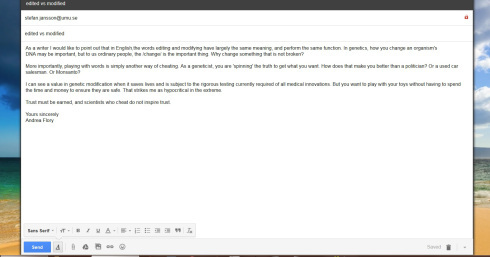
I don’t expect to receive a response, other than perhaps something derogatory, but I had to make the effort because we in the West are dying of spin, dying of lies, dying of hypocrisy.
Is it really so much to ask that our leaders, and the most emminent minds of our scientists act with integrity?
We are not children, and we are not stupid. If the only way you can get what you want is by trying to fool us, then what you want is not worth having.
Meeks
Filed under: GM food, My soap box Tagged: 2016, cabbage, editing, Europe, FDA, genetic, labelling, modification, Monsanto, Spin, Sweden, Umea, university








September 5, 2016
Why the Computer Viruses is Created?
Still on the theme of computer security, here’s some very well explained info. on computer viruses etc., and how they work. The info. on the ‘zombie’ network should give everyone pause for thought. I won’t say ‘enjoy’, but I hope you learn something that will make you safer in the future. Meeks.
As a computer technician, my clients frequently ask me “Why the computer viruses are created?”, especially after I have been called out to remove a virus from their computer. This is what I tell th…
Source: Why the Computer Viruses is Created?
Filed under: My soap box Tagged: botnet, computer, info. explanations, simple, trojan, virus, zombie








August 31, 2016
Stolen Dropbox passwords are circulating online. Here’s how to check if your account’s compromised — Quartz
If you got an email from Dropbox asking you to reset your password earlier this week, it’s a good idea to do it. Nearly 70 million stolen Dropbox passwords are circulating online, according to Motherboard, which obtained the data. The file-sharing service has confirmed the passwords are linked to a breach that took place in…
In view of my recent post about Cloud storage, this article from Quartz is super important…whether you use Dropbox or not.
Filed under: My soap box Tagged: 2016, Cloud, Dropbox, passwords, protect, Quartz, security








August 28, 2016
#Cloud storage & #sync.com…….or a positive tech post for a change!
After coping with the security issues of Windows 10, it was such a pleasant surprise to find an ‘app’ that is unabashedly security conscious! And yes, Sync.com, I’m talking about you. But first, a quick word about the problems that sync.com solves: storage, backup and version control.
Normally, when you create a file on your computer, you save it to your computer – i.e. onto the harddrive inside the physical ‘box’. If you’re super organised, you may also save that file to an external harddrive or USB device, as a form of ongoing ‘backup’. Belt-and-braces type people might save that data to a DVD as well, giving them multiple backups in case of disaster.
But all of these various types of storage have one, critical downside – a change made in one copy of the data will NOT be reflected in the other copies. If you have 3 copies of a particular file, you will have to manually update each copy.
There is also another issue that can be a nightmare – version control. Let me give you an example. Every time I work on my WiP [work in progress], I save it to my desktop, and then I copy it to my USB device. The latest version from the desktop always over-writes the version on the USB. Obviously, this is so I always have at least one copy of my work no matter what happens [e.g. the house burns down in a bushfire or some other catastrophe].
But what if I have 2 computers and want to add to my WiP on both?
That is the problem I’ve been struggling with for the last few days: there’s no point having the laptop if I don’t use it for my work, but if I do use it while I’m away from home, how do I keep the versions straight?
My fear is that if I continue with the USB device, sooner or later I am going to get the latest version of the WiP wrong. In a moment of madness or tiredness or distraction, I’ll over-write the wrong copy and then I’ll be up the creek without a paddle. Enter cloud storage.
Like the USB drive or DVD etc., cloud storage saves your files outside your pc, usually in a server on the other side of the world. The file is ‘up-loaded’ to the cloud via your internet connection, and once it’s there, you can access it from any computer device you choose. You can also share that file with others if you wish.
For me, cloud storage means I can work on my WiP at home and have it synced to my laptop so if I go out, I can continue working on the WiP where I left off.
Lovely concept, right?
Unfortunately, the grand-daddy of cloud storage – Dropbox – showed that cloud storage can be hacked, and most reviews I’ve read say their security has not improved much if at all since then. Now, I’m not working on anything ‘naughty’ that I need to hide from anyone, but privacy is very important to me, and I would die if I lost four years worth of work through someone else’s ‘oopsie’. So no Dropbox.:(
I was trawling through the umpteenth review/comparison of cloud storage offerings – there are heaps of them! – when I came across Sync.com. And guess what! The thing that sets sync.com apart from the rest is its security.
August 25, 2016
#Windows 10 updates – #Metered Connection
This how-to is for all non-US users of Windows 10 who have capped broadband plans – i.e. only get XX gigabytes of data per month.
Pre-Step A
Go to:
Start
Settings
Update & Security
Windows Update
Advanced Options
Now make sure ‘Choose How Updates are Installed’ is set to ‘Automatic (recommended)’ as shown below:
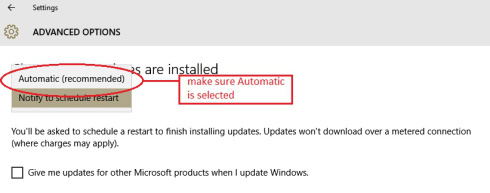
[Note: if this option is set to ‘Notify to reschedule restart’ at this point, Windows becomes…confused and could go into a perpetual loop. Mine did and I had to do a hard shutdown to get it to stop].
Step 1 – Finding the ‘Metered connection’ option
Click on the Start button and then select:
Settings
Network and Internet
Wifi
Advanced Options
Under ‘Metered connection’, click the slider button to show ‘on’:
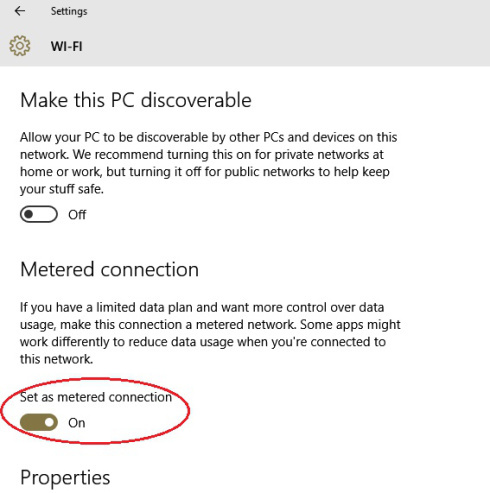
Step 2 – changing how Windows 10 updates are scheduled
Now go back to:
Settings
Update & security
Windows update
Advanced options
and under ‘Choose how updates are installed’, change ‘Automatic’ to ‘Notify to schedule restart’.
Now, Windows 10 will notify you of:
available updates, and
how much broadband they will use
but it will not download and install them automatically. This is what my laptop now shows:
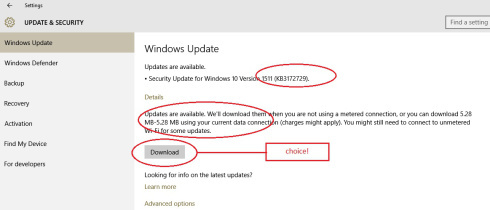
My heartfelt thanks to The Opening Sentence for showing me where the ‘Metered connection’ option was hiding! I feel a lot better now.
August 23, 2016
#Windows #10 – security and #privacy
I don’t normally review operating systems – I’m not that much of a geek – but I’ve decided to make an except for Windows 10. In a series of posts aimed at the ordinary user, I hope to answer the question – is this free upgrade worth it?
In my first post I ranted about the data-mining options I switched off during the initial setup of Windows 10. I wasn’t happy about those, but I thought that would be the worst of it. Wrong. In this second post, I’m going to talk about the lamentable Privacy options of Windows 10.
So, to begin. After finally getting Office 16 downloaded and setup on the new laptop, I decided to customise a few things, such as the display. It was while I was exploring the Windows 10 Settings that I took a good look at the Privacy options…and was shocked by what I found. By default, all the Privacy options are set to enable the Windows 10 apps to access all sorts of private information…to provide a better experience for the user.
Nothing wrong with that, right?
The answer depends a lot upon your age, memory and level of trust. I’m old enough to remember the spate of global computer virus epidemics of the early 2000s, most of which involved Microsoft Windows and Office products so I have no trust to spare.
To see what I’m talking about, check out the wikipedia link below. It details a timeline of computer viruses from the earliest to those happening right now. In particular, have a look at 2003-2004.
https://en.wikipedia.org/wiki/Timeline_of_computer_viruses_and_worms
The reason there were so many infections during that period was because hackers discovered the backdoors and sloppy code behind the pretty Windows GUI. If you’re my vintage, you probably remember what a thrashing Microsoft received for its poor design back then.
Given the speed, and dare I say it, desperation with which Microsoft threw Windows 10 together, I fear that sloppy code is once again a genuine possibility. Now, if you add to that the design of Windows 10 itself, the potential for security meltdowns increases exponentially.
Why? Because Windows 10 comes pre-loaded with ‘apps’ which are ALL given blanket security permissions…by default. The reason for this is that Microsoft is trying to position itself as the go-to place for all your internet needs. For those who don’t know their way around a computer, there are all these convenient apps that allow them to do pretty much whatever they want to do…from within Windows 10.
Need an email application? Forget about checking out Gmail or other webmail clients, just go with whatever Windows provides. Want to keep track of your Contacts? Again, there’s an app for that too, right there behind the Start button. And so on ad nauseum.
Meanwhile, for those who do know their way around, there’s a new browser and a new search wizard [make no mistake, Cortana is just a search bot].
Unfortunately, the price users pay for all this convenience is that Microsoft and its apps can monitor just about everything they do. More importantly, they have access to the internet so if Microsoft’s security is not as good as it should be, each app. is a potential entry point for some form of hacking.
But wait, there’s more. Even if nothing can access users’ data from the outside, that data is still available to Microsoft, and Microsoft makes no attempt to hide that it shares that data with other third parties. Don’t believe me? The following screenshot is taken from their own website:
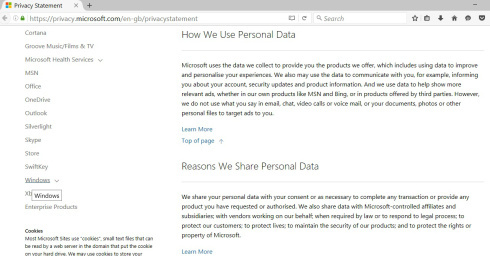
Or read it for yourself here:

Now, let’s have a look at what kind of data is collected and used by Microsoft:
Click the Start button in the bottom left hand corner of your Windows 10 task bar,
Click the option called ‘Settings’,
Select the option called ‘Privacy’.
Please note that in the following screenshots, I have changed ALL the options to off. The default mode for every option, bar one, is ‘on’. If you have not looked at the Privacy section before, all of your options will be set to ‘on’ as well.
The first screen you will see under Privacy is ‘General’ but I want to skip ahead to camera:
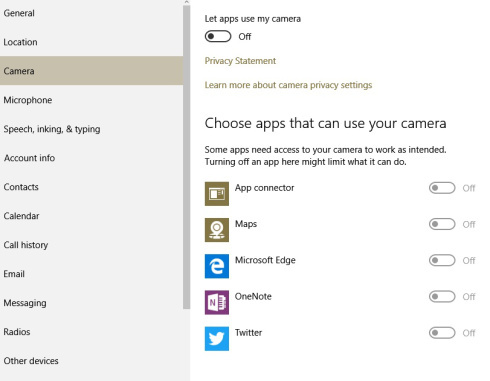
My new laptop is the first [and only] pc I have owned with an inbuilt camera. I almost didn’t notice it until the Offspring pointed it out. That camera is handy if you want to make a video conferencing type call, and if I were into that sort of thing, I might be pleased to have that camera ready to go. But look at all the apps that can use that camera. I assume the apps would not use the camera without my knowledge, but what if someone with malicious intent hacks one of the apps with access to that camera? ‘Nough said.
Next up is account info.:
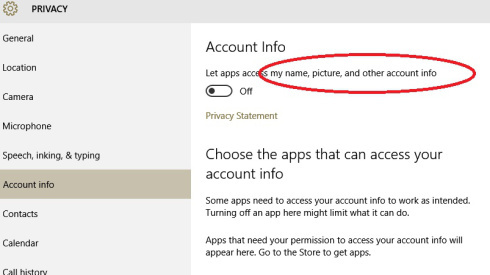
Call me a conspiracy theorist but wouldn’t this make life just so much easier for those who make a living from identity theft?
There are far too many Privacy options to go through each one individually, but in each one, apps are given access to personal and private information as well as the means to report on it. To whom? when? I don’t know, but if you look carefully, some of the options include warnings about broadband use. To me that means the apps are accessing the internet to talk to…who knows?
I can’t leave the topic of Privacy without looking at something Microsoft euphemistically terms ‘Feedback’. By definition, feedback is something I give. In Windows 10, Microsoft redefines feedback as ‘take‘ without choice:
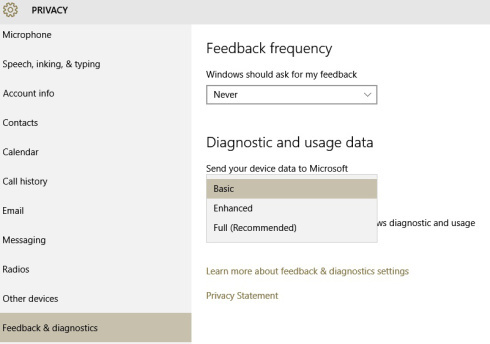
Please note that even with the ‘Feedback’ option set as ‘never’, there are only 3 options under ‘diagnostic and usage data’, and not one of them equals ‘none’ or ‘off’.
In earlier versions of Windows, when some glitch occurred, you would get a message asking if you wanted to send details of the error to Microsoft. Given the extent of the data included in those details, I’ve always said ‘no’. Now, apparently, that choice is no longer mine. Moreover, even the most ‘basic’ of data is more than you would think.
Adding insult to injury is the fact that Microsoft uses our own internet connections to send itself the data it has taken from our computers without asking. In the US, data is not an issue. Here in Australia, we have to pay for every KB of data we use.
I know that last point was petty, but I’m feeling vindictive and outraged, the more so because I know that millenials will find no problem with any of this. They are so used to handing over their privacy via their mobile phones, they won’t think twice about doing the same with Windows 10. Yet the security issues are just a hack waiting to happen, and I suspect Microsoft is aware of that.
When I bought my laptop, it came with Windows 10 pre-loaded. The box also came with a great big yellow and black warning sign to the effect that ‘this computer is not protected by anti virus security’ or something to that effect.
I raised an eyebrow at the ‘overkill’ represented by that warning, but now I’m not so sure. Could it be that Microsoft is relying on third party anti-virus software to stop its OS from leaking like a sieve?
Not happy Jan,
Meeks
p.s. UPDATE: For those who do want to use some of the Windows 10 apps, here’s a video that shows which Privacy options are the most critical to turn off.
It’s a short video and includes what I would consider the bare minimum for safety.
Filed under: Windows-10 Tagged: access, apps, broadband-use, data-mining, invasion, privacy, security-threat, third-party-companies, turn-off








August 18, 2016
#Microsoft, #Windows10 and #Office 16 vs my privacy
‘They’ say that we give away our privacy with both hands these days and thus, do not deserve to have it protected. Bullshit. We’re given no choice. Trigger warning – angry woman rant ahead.
Due to work, I had to buy a cheap laptop yesterday. It came with Windows 10 installed, and I bought the Office 16 suite to go with it [also for work]. I have now wasted the better part of a day just trying to get what I paid for to work.
First Windows 10.
Even though it was pre-loaded, the first time I fired up the laptop, I had to wait through a number of very slow ‘welcome-ish’ screens. It was so slow, I actually thought the laptop had hung on me. But no, just Microsoft at its best. [Oh and you can’t get out of these loading screens either].
Then, once the loading screens were done, I had to do some customisations. Microsoft pushes VERY hard to make you accept the ‘express’ option. DO. NOT. DO. IT! You will understand why after you select the ‘customise’ option. Essentially, this allows you to see exactly what is hidden behind the super convenient express option.
I can’t remember how many pages of customisation options there were, but they were all controlled by odd little slider buttons, and all of the sliders were set to ‘on’ by default.
To change the slider from ‘on’ to ‘off’, simply click on the left-hand side of the slider. It should now show as ‘off’.
What should you turn off? Everything. Literally.
I think I turned everything to off except maybe the last one that had to do with language and which version of English I wanted to use. Everything else was just sneaky data-mining. Or setting you up for all sorts of advertising and big brother type nonsense. I kid you not, you do not want any of those options set to yes. EVER.
Microsoft Edge
I have always hated the Microsoft browser so I used Edge only long enough to download Firefox. Once Firefox was installed, however, getting Win10 to accept it as the default browser was not at all straightforward or intuitive. To make using something else harder perhaps?
It can be done, just don’t expect it to be logical.
When you open the browser of your choice you will get a dialog box asking if you want to make it your default browser. Click yes.
You will now get a settings window that shows options for music, pictures and browsers etc. In this window, Edge will still be shown as the browser, and there is nothing to clue you in how to change it.
To permanently change your default browser, click on the Microsoft Edge. Only after you’ve done this completely unintuitive step will you be able to see any other browsers you have installed. Select the browser of your choice, answer any other questions thrown at you and you can finally surf the net how you want.
And finally Office 16.
This may not be news to everyone else out there, but it was to me: when you buy Office these days, you do NOT get a box with DVDs and manual inside. Instead, what you get is a small cardboard card. That’s it.
On the back of the card is a silvered strip similar to what you get on a scratch-it card. The writing on the card is tiny and up the very top in very tiny writing is the information that you need to scratch off the silver to get at the product code for the product you have already bought.
Right…
So now what?
I dutifully scratched off the silver and then looked for step 2. Hmm… I guess everyone else knows how to do this shit except me. I hate you Microsoft.
Finally, I noticed that inside the start button, [on the laptop not the scratch-it] the window, or whatever the hell it’s called, for Office was a different kind of colour to the other ones. Not greyed out or anything that intuitive, but different. So I clicked it and Win10 displayed a dialog box with three options, one of which was ‘activate’. Eureka!
I clicked the activate option and that’s where steam really started coming out of my ears. You see, despite having paid for Office 16, I’m not allowed to get Office 16…not without having an account with Microsoft first.
Not that big a deal, you say?
Yes, it is because in the past, when software came in boxes with proper instructions, registering your product was optional. Then Microsoft made it such that using your product depended upon activating it [but I don’t think you had to register?]. Now, you can’t even download something you’ve paid for without giving Microsoft a great deal of personal information:
a valid email address [okay, this is kind of normal]
name, country, date of birth? Why date of birth? Do people born before the millenium forfeit their rights or something? You do not need this information Microsoft.
#Amazon, US #Tax and #Australian Citizens
 Anything sold on Amazon – including self-published books – is subject to a 33% withholding tax.
Anything sold on Amazon – including self-published books – is subject to a 33% withholding tax.
This is a tax that Amazon must take out of the sale before you get your share.
This tax is applicable across the board and non-US citizens are not exempt.
Unless………..:
their country of origin has a trade treaty with the US
and they apply for an exemption under that trade treaty
As an Australian citizen, I am lucky enough to meet the ‘trade treaty’ criterion but until today, I did not apply for the exemption because:
I was not making enough money for it to matter, and
the process was just TOO HARD
I’m not sure what changed, or when exactly, but suddenly the process of applying for an exemption is so easy I’m still pinching myself in case I’m dreaming.
So what’s needed?
Your country of origin must have a trade treaty with the US
You must have an account with Kindle Direct Publishing [nah..really? lol]
You must have a tax file number [or equivalent] from your country of origin
Seriously, that’s it. With those three things you can log into Kindle Direct Publishing and fill in a very VERY easy online form and you’re done.
Log in to your KDP account
Select My Account
Select the option for Tax Interview
Have your tax file number handy
And start filling in the questions.
When you get to the page that asks if you want to do an electronic signature* – select YES
The electronic signature is nothing more than your typed name, email address [same as for logging into KDP] and ‘Submit’.
Be sure to print off a copy at the end and you’re done.
If you’re anything like me, you’ll sit there scratching your head and wondering how you can send an electronic signature. Is there a special program you have to invest in to create such a signature? Or do you have to print the page off, sign it manually and then post it off? Hah!
The answer to all those questions is a big, fat NO. There appears to be no valid reason for doing things the hard way, so don’t.
Having procrastinated for years, literally, I am so relieved to finally have this Sword of Damocles removed from my halo. Thank you IRS and thank you Amazon! Now if only I could be paid via PayPal or EFT I’d be delirious with happiness…
-smack- Don’t be greedy, girl!
Much happy dancing,
Meeks
Filed under: How-to guides Tagged: 33%, Australia, books, exemption, how-to, IRS, non-US-citizens, self-publishing, tax, US, Withholding








August 17, 2016
From biscuits to Viagra?
I rarely go into my spam folder, but I did today and discovered that the keywords ‘New’ and ‘Improved’ [in the title of a post] can attract some interesting spam.
The post in question was my rant about Arnotts BBQ Shapes biscuits which are marketed as ‘new and improved’…and are anything but. I stand by my comments about the biscuits, but I may to think twice about my titles in the future. Then again, just including viagra in the title of this post may bring even more spammers to my door. I’ll keep you posted.
This is a screenshot of one of the viagra ones:

The kinky porn ones I’ll leave to your imagination, other than to say they seem to be attracted to the word ‘sexy’ in my post ‘Villains – what is it that makes them so sexy?‘.
On a brighter note, I’m immensely relieved that only 11 of my comments are from spammers. That’s not bad over four years and almost 12,000 comments.






